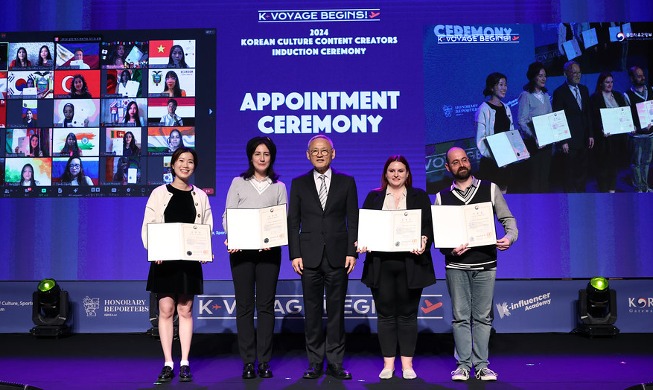-
 Korea.net's 24-hour YouTube channel
Korea.net's 24-hour YouTube channel- NEWS FOCUS
- ABOUT KOREA
- EVENTS
- RESOURCES
- GOVERNMENT
- ABOUT US

Some foodstuffs are always on the Korean table, next to the kimchi. Pepper paste, or gochujang, is perhaps the most common of these.
It is a fermented red chili paste. To make it, soft-boiled rice or glutinous rice powder is mixed with fermented soybean powder. Chili powder and salt are added according to taste and the mixture is then fermented to perfection.
Pepper paste is an unmissable condiment in the Korean kitchen and a staple of the traditional diet. Its unique spicy taste has a special power that makes people regain their appetite, especially during the hot summer months. In 2009, researchers at the Yonsei University College of Medicine found that capsaicin, the element in chili peppers that makes them "hot," actually represses inflammation of the cells in the gastric mucous membrane that are infected by Helicobacter pylori, the cause of various gastric diseases, such as gastritis.
Historical records say that chilies were first brought to Korea in the late 16th century during Joseon times (1392-1910), via Japan. The spicy taste became stronger when it was combined with various indigenous food ingredients, like vegetables, fish and meat. Gochujang is believed to have been first made as a food item during these times. Pepper paste was traditionally made at home, but nowadays it has been reborn as a mass produced food item alongside the nation's rapid industrialization.
There is one company that has been making gochujang for 66 years: the Jinmi Foods Company, based in Chungcheong. The firm first began operations as a soybean sauce producer in Daejeon, Chungcheongnam-do (South Chungcheong Province), in 1948. During the '60s and '70s, the firm developed an expertise in producing fermented paste varieties, such as pepper paste, soybean paste or doenjang, Chinese black noodle paste or chunjang and the dipping sauce made with soybean paste for lettuce wraps, or ssamjang. The company's market share lessened during the '90s due to the penetration of larger enterprises into the fermented paste market. Since then, however, Jinmi has been able to solidify its position as a leading firm specialized in fermented paste with its control of the fifth largest share of the market.
In the 2000s, Jinmi set up a research center and developed its in-house brands in collaboration with large-scale wholesalers, strengthening its position in the market.
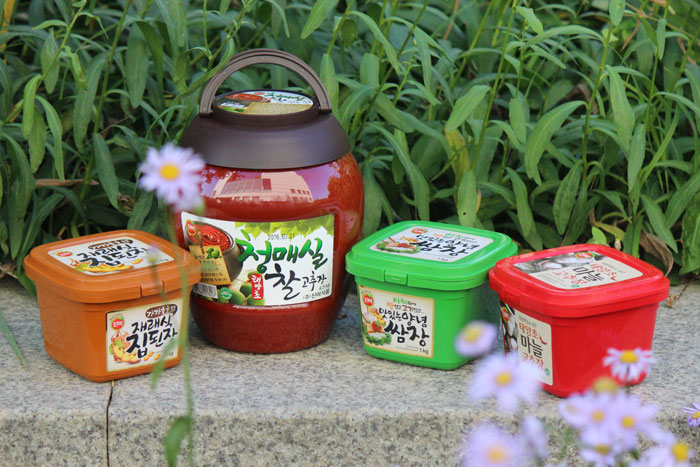
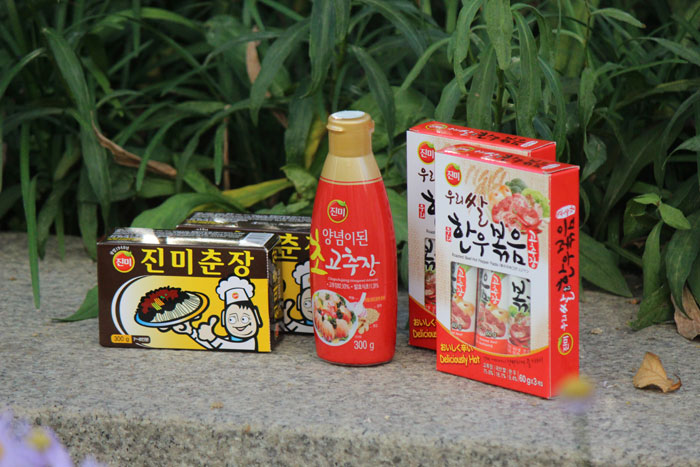
In July 2011, Jinmi moved its factory to Goesan in Chungcheongbuk-do (North Chungcheong Province) and secured new state-of-the-art facilities, ushering in the second phase of its turning point. The decision was made as North Chungcheong Province and Goesan County cooperated to support the fermentation industry. From 2007 to 2011, both the provincial and county offices injected more than KRW 16.2 billion into the building of a fermented food factory. Jinmi then purchased the factory and has invested an additional KRW 34 billion every year into developing adjacent facilities.
The newly built factory complex can produce as much as 1,300 tons of gochujang pepper paste and up to 700 tons of other varieties of fermented paste: the doenjang, chunjang and other mixed paste products. It was authorized as a Hazard Analysis and Critical Control Point (HACCP) by the Ministry of Food and Drug Safety in 2012. Then in 2013, it received its overseas manufacturers pre-registration certification from the Food and Drug Administration of the U.S., a certification which vouches for its sanitation and safety levels.
Focusing on diversifying its product line, Jinmi has recently developed five varieties of glutinous rice red pepper paste and oduk soybean malt soybean paste. These are all hand-made to maintain the traditional flavor. The firm has also won popularity by making various sauce lines, such as its mixed sauce or bibimjang, its sauce for mixed noodles or bibim guksujang, and then with its naengmyeonjang, jjolmyeonjang and other sauces.
Jinmi entered the U.S. market in September 2011 when it started to supply pepper paste and soybean paste to retail outlets across the Los Angeles area. The firm has been expanding its range of products from pepper paste to the overall fermented paste and sauce market. Its chunjang paste has been a top seller among makers of Chinese black noodles or jajangmyeon. The firm has even received a growing number of chunjang orders from China itself, where jajangmyeon originated.
Despite the competition it faces from larger firms with their penetration into the fermented food market, Jinmi maintains an annual sales profit of some KRW 32 billion and controls the fifth largest market share. The key to its success is its unending research and technological development and its honesty with its customers, says the company.
More information about Jinmi Foods Company is available at its homepage in English, Japanese and simplified Chinese:
http://www.jinmifoods.co.kr/main/main.php
Article by Wi Tack-whan, Yoon Sojung
Photos: Wi Tack-whan
Korea.net Staff Writers
whan23@korea.kr
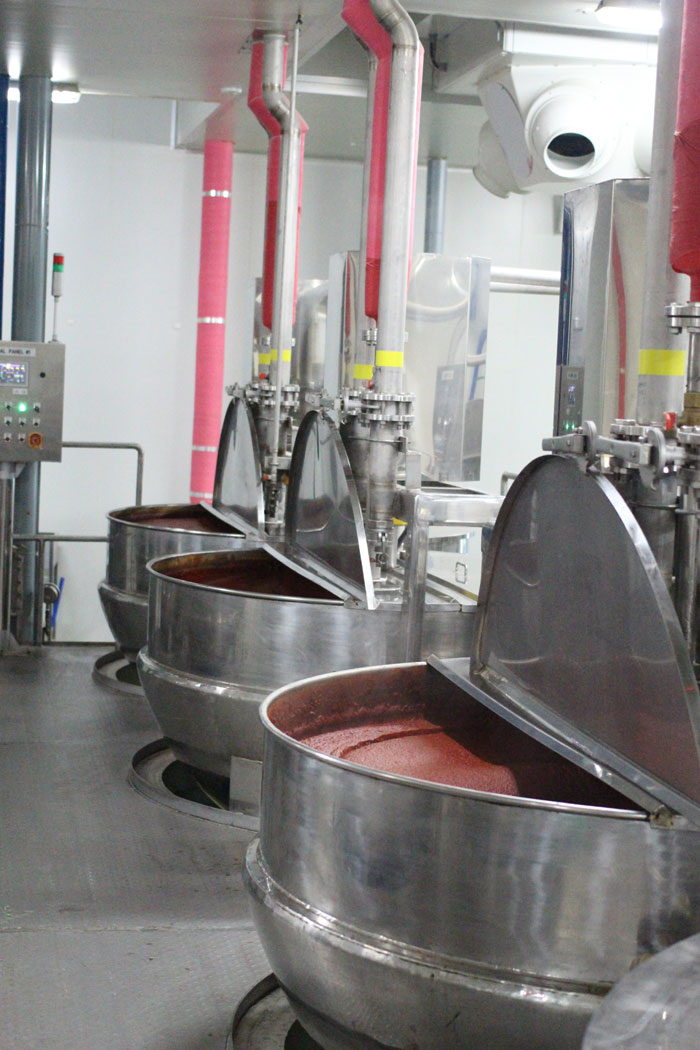
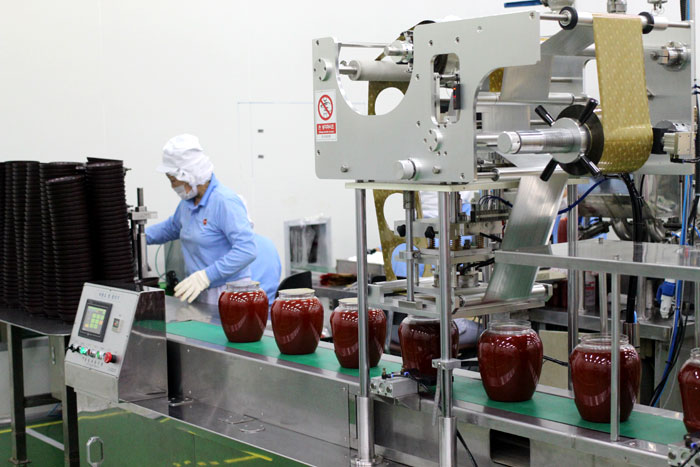
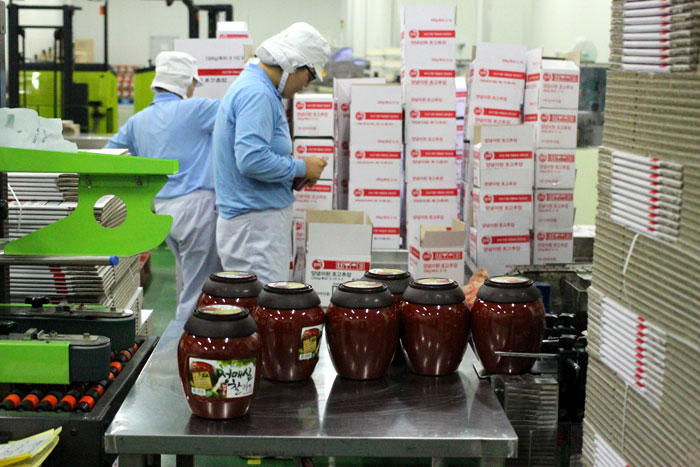
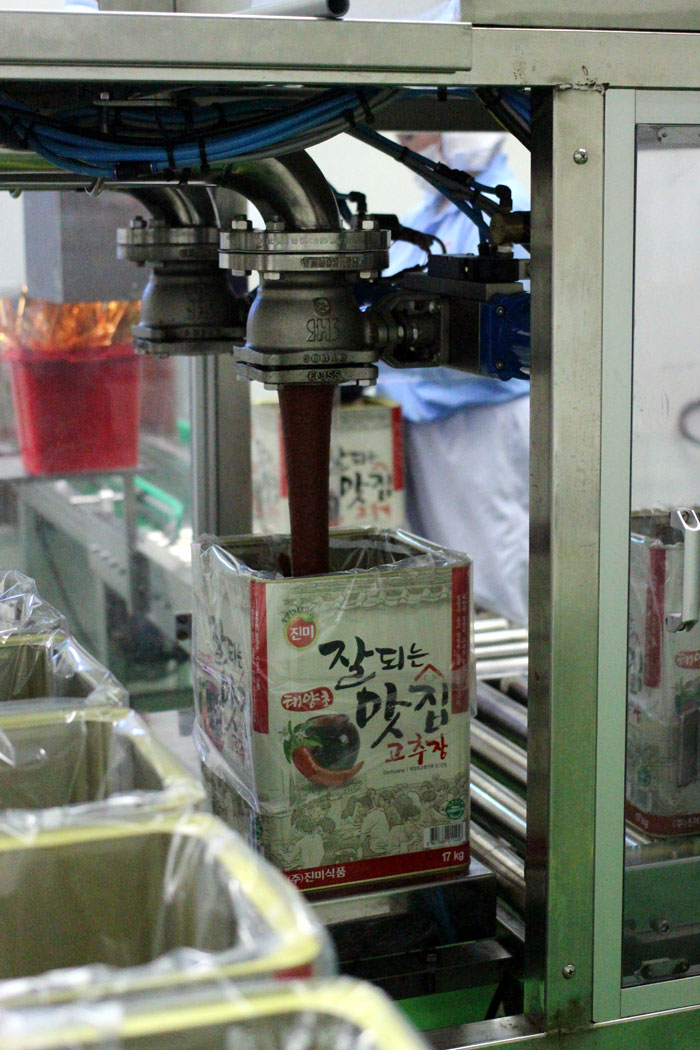
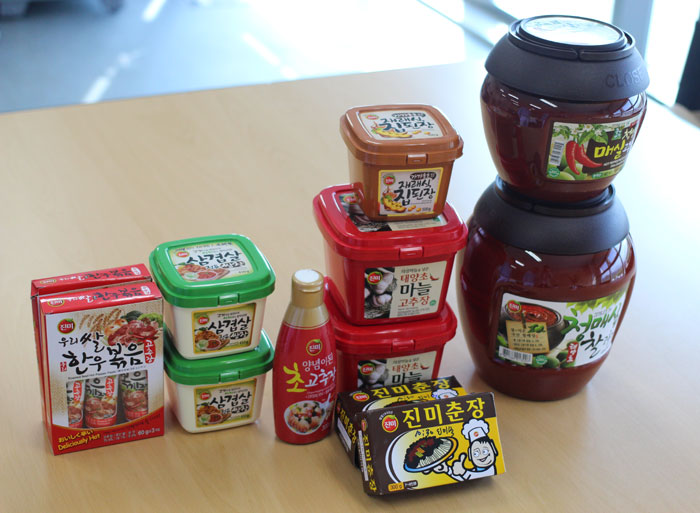
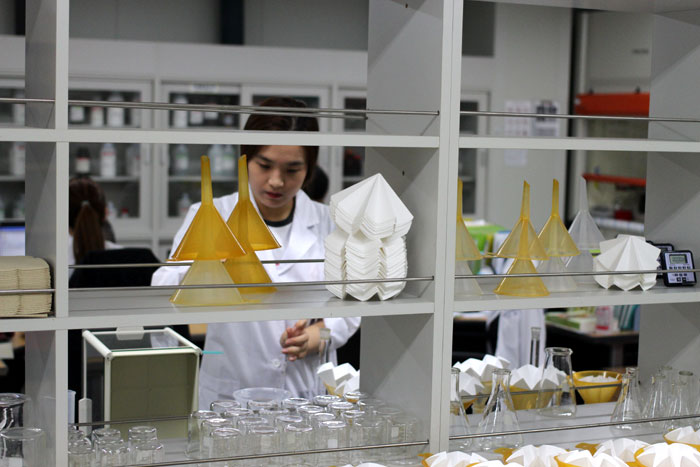
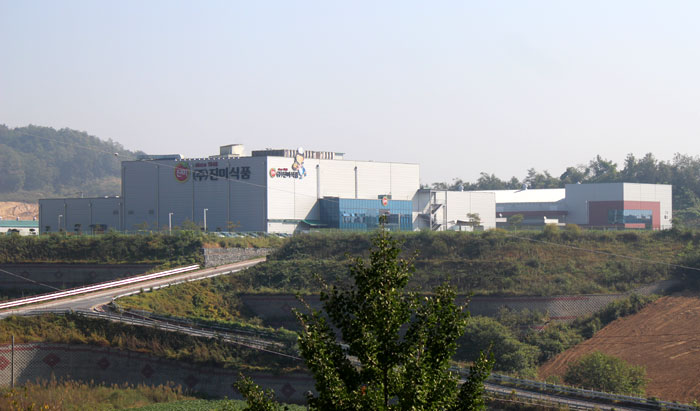
It is a fermented red chili paste. To make it, soft-boiled rice or glutinous rice powder is mixed with fermented soybean powder. Chili powder and salt are added according to taste and the mixture is then fermented to perfection.
Pepper paste is an unmissable condiment in the Korean kitchen and a staple of the traditional diet. Its unique spicy taste has a special power that makes people regain their appetite, especially during the hot summer months. In 2009, researchers at the Yonsei University College of Medicine found that capsaicin, the element in chili peppers that makes them "hot," actually represses inflammation of the cells in the gastric mucous membrane that are infected by Helicobacter pylori, the cause of various gastric diseases, such as gastritis.
Historical records say that chilies were first brought to Korea in the late 16th century during Joseon times (1392-1910), via Japan. The spicy taste became stronger when it was combined with various indigenous food ingredients, like vegetables, fish and meat. Gochujang is believed to have been first made as a food item during these times. Pepper paste was traditionally made at home, but nowadays it has been reborn as a mass produced food item alongside the nation's rapid industrialization.
There is one company that has been making gochujang for 66 years: the Jinmi Foods Company, based in Chungcheong. The firm first began operations as a soybean sauce producer in Daejeon, Chungcheongnam-do (South Chungcheong Province), in 1948. During the '60s and '70s, the firm developed an expertise in producing fermented paste varieties, such as pepper paste, soybean paste or doenjang, Chinese black noodle paste or chunjang and the dipping sauce made with soybean paste for lettuce wraps, or ssamjang. The company's market share lessened during the '90s due to the penetration of larger enterprises into the fermented paste market. Since then, however, Jinmi has been able to solidify its position as a leading firm specialized in fermented paste with its control of the fifth largest share of the market.
In the 2000s, Jinmi set up a research center and developed its in-house brands in collaboration with large-scale wholesalers, strengthening its position in the market.


The main products of the Jinmi Foods Company. Jinmi makes a variety of fermented pastes ranging from pepper paste and soybean paste, through to Chinese black noodle paste and even the soybean paste dipping sauce used when eating lettuce wraps.
In July 2011, Jinmi moved its factory to Goesan in Chungcheongbuk-do (North Chungcheong Province) and secured new state-of-the-art facilities, ushering in the second phase of its turning point. The decision was made as North Chungcheong Province and Goesan County cooperated to support the fermentation industry. From 2007 to 2011, both the provincial and county offices injected more than KRW 16.2 billion into the building of a fermented food factory. Jinmi then purchased the factory and has invested an additional KRW 34 billion every year into developing adjacent facilities.
The newly built factory complex can produce as much as 1,300 tons of gochujang pepper paste and up to 700 tons of other varieties of fermented paste: the doenjang, chunjang and other mixed paste products. It was authorized as a Hazard Analysis and Critical Control Point (HACCP) by the Ministry of Food and Drug Safety in 2012. Then in 2013, it received its overseas manufacturers pre-registration certification from the Food and Drug Administration of the U.S., a certification which vouches for its sanitation and safety levels.
Focusing on diversifying its product line, Jinmi has recently developed five varieties of glutinous rice red pepper paste and oduk soybean malt soybean paste. These are all hand-made to maintain the traditional flavor. The firm has also won popularity by making various sauce lines, such as its mixed sauce or bibimjang, its sauce for mixed noodles or bibim guksujang, and then with its naengmyeonjang, jjolmyeonjang and other sauces.
Jinmi entered the U.S. market in September 2011 when it started to supply pepper paste and soybean paste to retail outlets across the Los Angeles area. The firm has been expanding its range of products from pepper paste to the overall fermented paste and sauce market. Its chunjang paste has been a top seller among makers of Chinese black noodles or jajangmyeon. The firm has even received a growing number of chunjang orders from China itself, where jajangmyeon originated.
Despite the competition it faces from larger firms with their penetration into the fermented food market, Jinmi maintains an annual sales profit of some KRW 32 billion and controls the fifth largest market share. The key to its success is its unending research and technological development and its honesty with its customers, says the company.
More information about Jinmi Foods Company is available at its homepage in English, Japanese and simplified Chinese:
http://www.jinmifoods.co.kr/main/main.php
Article by Wi Tack-whan, Yoon Sojung
Photos: Wi Tack-whan
Korea.net Staff Writers
whan23@korea.kr







The factory complex is jointly built by Goesan County and North Chungcheong Province. It is equipped with production and research facilities and makes a variety of fermented pastes and sauces.



